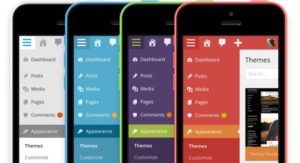WordPress is the most popular website creation software in the world. What started in 2003 as a blogging platform has developed over the years to become a fully-fledged, highly capable publishing tool used by big names throughout the world.
More recently, in particular, it has seen significant functional improvements that allow for greater customisation and therefore more flexibility for business websites.
And by becoming a business tool rather than a technical one, it brings you closer to your customers.
We watched with interest as the swing towards a content management system (CMS) started making it feasible for use as a base system for our customer websites.
In 2008, we deployed it on our own website and ran it for a year as a test. At that time, it was rejected by many developers as ‘nothing more than a blogging platform’, but we were so captivated by its ease of use and potential for getting website owners to take control of their content, that we started rolling it out on our customer websites, and have since built over 200 sites with the software, from one-pagers to complex e-commerce systems, mobile websites and large sites for corporate customers with seven-figure turnovers.
Today, more than a decade later, it’s fair to say that it is used widely by most developers.
WordPress is flexible
WordPress is flexible because of its modular nature. Out of the box, it is a no-frills CMS offering the functionality to publish posts and pages with pictures. This rudimentary configuration makes it ideal as a starting point for most websites. No bells and whistles means it is efficient, and simple websites require very little in the way of additional functionality.
For more complex websites, the barebones system provides a solid ‘chassis’ on which to build powerful functionality such as e-commerce, databases, directories, document management, media distribution and much more.
WordPress evolves to allow customisations to take place without breaking it. The software is maintained by regular updates to meet new developments such as those posed by mobile devices and new languages such as HTML5 and code libraries such as jQuery.
Despite months of work to bring these updates to market, they’re applied within seconds, making your website secure, current and flexible, with very little effort.
And because it’s open source, all the updates are free, making it an economical choice for cost-conscious businesses.
Separating design from content
In WordPress, all the design elements and layout are part of the file structure. All the content is contained in the database.
That means that the design can be changed without affecting the content. And vice versa. For us, it means we can have a relationship with our clients where we each have distinct roles which do not interfere with one another. Again those roles can flex depending on the client’s wish or capability.
Stable resources
Way back in 2008, our decision to use WordPress wasn’t taken lightly. Although it was already five years old, it was fairly new as a CMS, but we were ready to buy into it, and look at ways we could add value for our clients.
Frameworks were also new but provided a solid base on which to develop websites en masse.
A newcomer called Genesis was just appearing on the market and we immediately saw the potential for it to provide us with a robust platform on which to build websites.
We’re still using Genesis today and it was without a doubt, a move which has created a seam of consistency and robustness throughout our websites.
Likewise, there have been e-commerce platforms for WordPress over the years which have had mixed reactions. But when WooCommerce came along, it changed everything. It’s now the number one e-commerce solution for WordPress sites. And like WordPress it too has become a platform in itself, a barebones system with hundreds of extensions, making it a lightweight base that can easily be adapted to suit every need.
With recent developments, such as the REST API, it now provides deeper functionality and customisation options.
Looking back, I think we recognised WooCommerce as a winner from the day it landed, and it’s one of our favourite lines to say we have e-commerce sites with product catalogues from three items to 40,000. If that doesn’t sum up flexibility, nothing ever will.
The future of WordPress
The WordPress update cycle produces improvements which sometimes are never seen in the front end, but progress in back-end functionality is often the most important as this is where you, the customer, will spend your time. It comes back to the ‘relationship’. I’ve lost count of the number of WordPress sites which have inspired business owners to actively get involved with their sites and take an interest in using their website to market their business.
It takes something special to make that happen.


